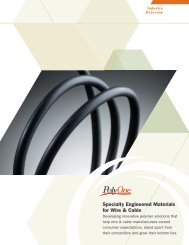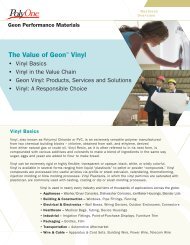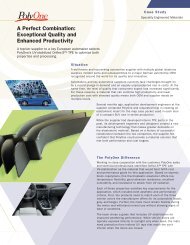HOT MELT VINYL PLASTISOLS - PolyOne
HOT MELT VINYL PLASTISOLS - PolyOne
HOT MELT VINYL PLASTISOLS - PolyOne
Create successful ePaper yourself
Turn your PDF publications into a flip-book with our unique Google optimized e-Paper software.
<strong>HOT</strong> <strong>MELT</strong> <strong>VINYL</strong> <strong>PLASTISOLS</strong><br />
TECHNICAL ASSISTANCE BRIEF<br />
NUMBER: SC003<br />
Hot melt vinyl plastisols are liquid dispersions of polyvinyl chloride (PVC)<br />
resins, plasticizers, and miscellaneous additives. When properly<br />
compounded, these plastisols have sufficient heat stability and flow<br />
characteristics to enable the processor to pour or inject the molten plastisol<br />
into a cold or room temperature mold.<br />
At typical processing temperatures of 330ºF (166ºC) to 360ºF (182ºC), these<br />
plastisols exhibit low enough viscosity to allow the plastisol to flow (or pour).<br />
When cool, the hot melt vinyl plastisol is transformed into a soft rubbery<br />
substance, at which time the finished part can be removed from the mold.<br />
Processing Equipment<br />
Initial heating and melting as well as subsequent re-melting of hot melt vinyl<br />
plastisols is done most efficiently in a container having excellent heat transfer<br />
and as much surface area as practical in contact with the heat source.<br />
Preferred materials for the heating vessel are aluminum, nickel, stainless<br />
steel, porcelain or Pyrex type glass. Ordinary steel might suffice, but<br />
hydrogen chloride will cause corrosion. Copper is also corroded by HCI and<br />
should not be used.<br />
Vinyl is an excellent thermal insulator. Therefore, it is necessary to<br />
continually agitate the plastisol in the heated vessel. Slow positive agitation,<br />
which scrapes the surface vessel, will help prevent localized degradation.<br />
It is necessary to use a heat source with temperature control (i.e. a jacketed<br />
tank with heated, circulating oil). A thermostatically controlled hot oil bath<br />
would be an ideal heat source, but satisfactory results have also been<br />
obtained by using electric hot plates, provided care is taken to keep heat<br />
distribution even and at all times below 400ºF (204ºC). Due to the fact that<br />
degradation will occur rapidly at extremely high temperature, use of an open<br />
flame or electric element is generally unsatisfactory.<br />
Vessel temperatures should be set to at least 400ºF (204ºC). Some<br />
manufacturers may use temperature settings as high as 450ºF (232ºC), but<br />
care must be exercised as temperatures are increased above 400ºF (204ºC).<br />
1
An air convection oven with uniform heating and reasonably accurate heat controls is<br />
also an excellent source for processing hot melt vinyl plastisols. Use an oven setting of<br />
400ºF (204ºC) to bring the hot melt to 360ºF (182ºC) before pouring.<br />
If an open container is used for heating on a hot plate a second heat source above the<br />
plastisol will speed the melting process. This second heat source could be infrared<br />
heaters or a heating coil. If this is not practicable to a certain application, a simple lid<br />
over the container being heated will prevent the molten surface of the plastisol from<br />
cooling.<br />
Master Mold Preparation<br />
Molds can be made of any material that is not attacked by the plasticizers in the hot<br />
melt vinyl plastisol formulation. Styrene, ABS, nitrocellulose, and many acrylics are<br />
attacked rapidly. A good test for a mold making material is to immerse the mold<br />
material in the liquid, un-fused plastisol for 24 hours to check for softening or distortion<br />
of the potential mold material. Mold materials containing moisture (i.e. wood and paper)<br />
may cause surface blistering and should generally be used very cautiously. A mold<br />
material that has been used satisfactorily is RTV Silicone.<br />
Preparation of the master for accepting the molten plastisol varies with the master type.<br />
A smooth metal master need only be preheated from 200ºF (93ºC) to 250ºF (121ºC)<br />
before pouring of the hot melt vinyl plastisol. A wooden master should be coated<br />
thoroughly with shellac. A porous plaster master should be coated with a soap, wax or<br />
silicone release agent to inhibit mechanical adhesion of the plastisol to the master. To<br />
protect the master from possible thermal shock damage when pouring the plastisol,<br />
preheat the master to 250ºF (121ºC).<br />
Plastisol Processing<br />
The hot melt vinyl plastisol, as supplied, is a low viscosity liquid. Conversion is<br />
accomplished by heating the plastisol until the PVC resin in the plastisol is solvated by<br />
the liquid plasticizers in the plastisol, and further heated to a high enough temperature<br />
for proper flow and fusion. Minimum temperature for fusion is about 330°F (166°C).<br />
Minimum temperatures for molten flow depend upon the plastisol formulation, its<br />
hardness, and the process technique, but could vary from 330°F (166°C) upward.<br />
As the hot melt vinyl plastisol warms in the vessel, it will begin to phase from a liquid to<br />
a solid at around 250ºF (121ºC). At this point, the plastisol can be visually described as<br />
a lump surrounded by liquid. The plastisol will remain solid until the temperature<br />
reaches approximately 330°F (166°C) (many customers are worried about the presence<br />
of this solid phase, but should rest assured that it is a normal phenomenon). After the<br />
plastisol reaches the approximate 330°F (166°C) temperature, the solid material will<br />
begin to phase back into a liquid state.<br />
2
It is important to understand that the hot melt vinyl plastisol be stirred during the heating<br />
process to assure more uniform heating of the mass. Additionally, the stirring of the<br />
plastisol will help break up the solid phase quicker.<br />
If a cup or dipper is used to pour the hot melt vinyl plastisol it should be paced in the<br />
molten plastisol at least 15 minutes before pouring so that it will reach an equilibrium<br />
temperature.<br />
When additional plastisol is required, add fresh plastisol from the shipping container<br />
direct to the heat exchanger and stir. If solid (previously processed) and the hot melt<br />
vinyl plastisol is to be reused for molds, cut the plastisol into thin sections and melt it in<br />
a batch of already molten plastisol. The greater the surface area of the solid plastisol,<br />
the faster it will melt.<br />
Excessive heat will cause degradation. Initially degradation is evidenced by<br />
discoloration. Eventually, hydrogen chloride (HCl), a corrosive, somewhat toxic,<br />
noxious gas, is liberated.<br />
Pouring (Molten Plastisol)<br />
Pouring the hot melt vinyl plastisol over the preheated, non-porous master should be<br />
done in a uniform, continuous manner. Take care not to pour too rapidly so as to trap<br />
air bubbles. A smooth even coating over the surface of the master should be poured<br />
first while the viscosity is low, then completely fill the cavity in which the master is<br />
mounted with plastisol.<br />
Properties<br />
Compounds of any color, including clear, can be utilized. Hardness values ranging from<br />
8 Shore A (fishing lures) to 30 Shore A (casting molds) can be utilized. Surface feel<br />
(slimy to dry), chemical resistance, and other desired characteristics can be supplied<br />
upon request.<br />
The plasticizers in hot melt vinyl plastisols are also plasticizers for other plastics and<br />
many materials used in paints and lacquers. Prolonged contact, with the part, can<br />
result in plasticizer migration with resultant marring or degradation. Often, proper<br />
compounding of the hot melt vinyl plastisol can prevent or reduce plasticizer migration.<br />
Copyright © 2010, <strong>PolyOne</strong> Corporation. <strong>PolyOne</strong> makes no representations, guarantees, or warranties of any kind with respect to the Information contained in this document<br />
about its accuracy, suitability for particular applications, or the results obtained or obtainable using the information. Some of the Information arises from laboratory work with<br />
small-scale equipment which may not provide a reliable indication of performance or properties obtained or obtainable on larger-scale equipment. Values reported as “typical” or<br />
stated without a range do not state minimum or maximum properties; consult your sales representative for property ranges and min/max specifications. Processing conditions<br />
can cause material properties to shift from the values stated in the Information. <strong>PolyOne</strong> makes no warranties or guarantees respecting suitability of either <strong>PolyOne</strong>’s products<br />
or the Information for your process or end-use application. You have the responsibility to conduct full-scale end-product performance testing to determine suitability in your<br />
application, and you assume all risk and liability arising from your use of the Information and/or use or handling of any product. POLYONE MAKES NO WARRANTIES,<br />
EXPRESS OR IMPLIED, INCLUDING, BUT NOT LIMITED TO, IMPLIED WARRANTIES OF MERCHANTABILITY AND FITNESS FOR A PARTICULAR PURPOSE, either with<br />
respect to the Information or products reflected by the Information. This literature shall NOT operate as permission, recommendation, or inducement to practice any patented<br />
invention without permission of the patent owner.<br />
<strong>PolyOne</strong> Corporation / 33587 Walker Road, Avon Lake, Ohio 44012<br />
TAB-SC003 10-2010<br />
3


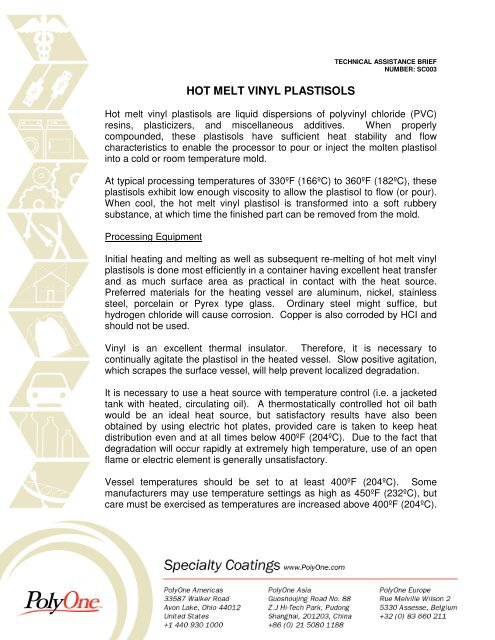

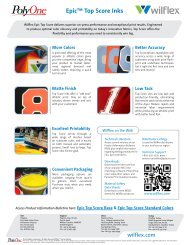
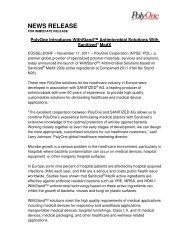

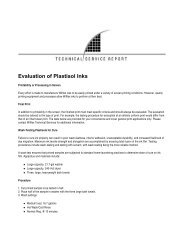
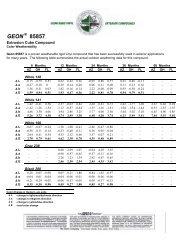
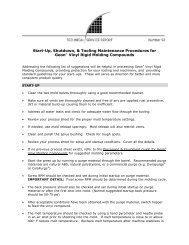
![TPE Injection Molding Guide [PDF] - GLS Thermoplastic Elastomers](https://img.yumpu.com/26329362/1/190x245/tpe-injection-molding-guide-pdf-gls-thermoplastic-elastomers.jpg?quality=85)

